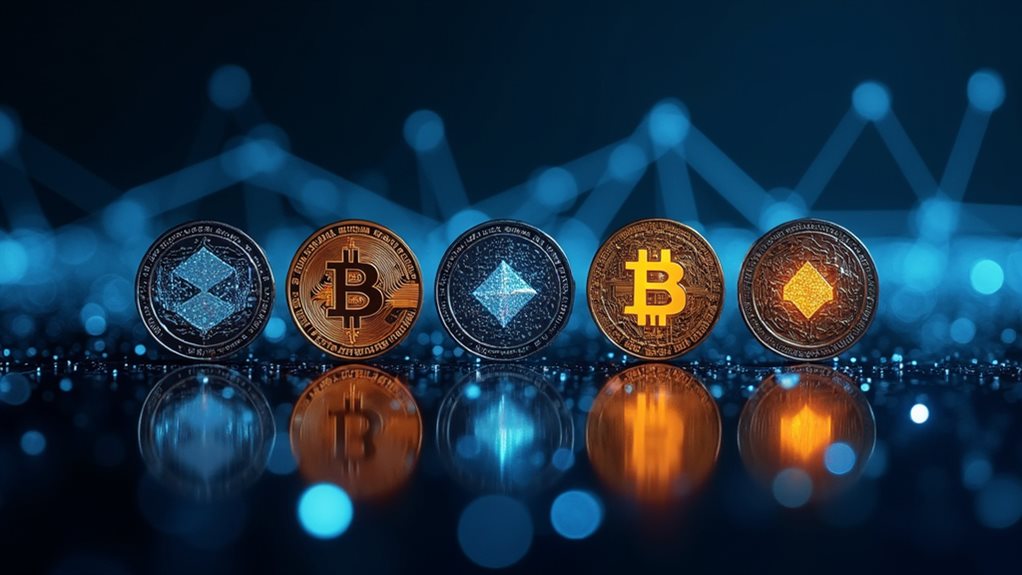Altcoins have taken center stage in 2025's crypto markets, with Mantra (OM) crushing it at a 92.71% gain. XRP follows with 25.04%, while privacy-focused Monero clocks 18.89%. Bitcoin's new $110K high hasn't stopped over 16,000 altcoins from battling it out. Some coins rely on pure hype (looking at you, Dogecoin), while others like Alephium actually build stuff. AI projects and Layer 2 solutions are heating up, but predictions remain as reliable as a fortune cookie. The real story lies in what's driving these digital assets forward.

While Bitcoin still commands attention in 2025, altcoins are stealing the spotlight with jaw-dropping gains. Mantra (OM) leads the pack with a staggering 92.71% year-to-date performance, making other cryptocurrencies look like they're moving in slow motion. XRP isn't doing too shabby either, with a 25.04% gain as it continues revolutionizing payment solutions. And let's not forget Monero, the privacy-obsessed coin that's up 18.89% – because apparently, some people still value keeping their transactions secret in 2025. Successful projects demonstrate strong community engagement through active social channels and regular developer updates.
Altcoins dominate 2025's crypto scene, with Mantra's 92.71% surge leading the charge while XRP and Monero show impressive gains.
The crypto landscape has evolved dramatically, with some familiar faces and new players shaking things up. Experienced traders often use copy trading tools to mirror successful strategies. Solana keeps bragging about its lightning-fast transactions and dirt-cheap fees, but those pesky interoperability issues just won't go away. Meanwhile, Aptos and Arbitrum are busy trying to solve blockchain's scaling problems – good luck with that, folks. Bitcoin recently hit an all-time high of nearly $110,000 in January. With over 16,000 altcoins now existing in the market, competition for attention has never been fiercer.
The real entertainment comes from watching Dogecoin. Sure, it's got a massive community, but let's be honest – it's still just a meme with a cute dog logo. But hey, who needs utility when you've got millions of fans?
Speaking of utility, some newcomers are actually trying to bring something useful to the table. Alephium is building new blockchain infrastructure, while ThoughtAI and LilAI are jumping on the AI bandwagon – because apparently, everything needs AI these days.
Market predictions for 2025 are all over the place. Cardano could hit anywhere from $0.68 to $2.22, while Polkadot might swing between $4.81 and $18.01. Avalanche could soar to $95.11 or crash to $26.12. It's like throwing darts blindfolded, but with better odds.
The emergence of AI-focused altcoins like Dawgz AI is turning heads, while established players like UNUS SED LEO keep steady. Layer 2 solutions are becoming the cool kids on the block, with projects racing to solve Ethereum's scaling woes. Even stablecoins are getting creative – just look at Ethena USDe trying to carve out its niche.
Trading volume and market sentiment continue driving these wild price swings. Some projects are actually delivering real-world solutions, while others just ride the hype train. Community support matters more than ever – just ask any successful altcoin developer.
The crypto market of 2025 proves one thing: innovation sells, but sometimes a good meme and strong marketing work just as well.
Frequently Asked Questions
How Do Government Regulations Affect the Growth Potential of Emerging Altcoins?
Government regulations have a make-or-break impact on emerging altcoins.
Clear frameworks boost investor confidence and attract institutional money. But harsh crackdowns? They can kill promising projects overnight.
Regulatory clarity helps exchanges operate legally, while uncertainty scares away potential backers.
Cross-border rules matter too – what happens in the U.S. or EU ripples globally.
The sweet spot? Smart regulation that protects investors without strangling innovation. No easy task.
What Security Measures Protect Investors From Altcoin Scams and Fraud?
Investors protect themselves from crypto scams through multiple defensive layers.
Hardware wallets and cold storage keep assets physically secure.
Two-factor authentication and private key management prevent unauthorized access.
Due diligence matters – legitimate projects have transparent teams and real use cases.
Red flags? Promises of guaranteed returns, aggressive shilling, and anonymous developers.
Reputable exchanges with regulatory compliance add another security buffer.
Still, scammers keep innovating.
No system's perfect.
Which Crypto Exchanges Are Most Reliable for Trading These Altcoins?
For altcoin trading, Kraken and Coinbase stand out as top-tier reliable exchanges.
Kraken's impressive security setup includes cold storage and proof of reserves, plus they support over 370 cryptocurrencies.
Coinbase, though pricier, offers bank-level security and regulatory compliance.
Binance.US brings low fees to the table but lacks some features.
Let's be real – these platforms aren't perfect, but they're the closest thing to "trustworthy" in crypto's wild west.
How Do Altcoin Transaction Fees Compare to Traditional Banking Costs?
Altcoin transaction fees crush traditional banking costs – it's not even close.
While banks charge ridiculous fees of $25-100+ for wire transfers, most altcoin transactions cost between $1-10. Talk about highway robbery!
Network congestion can spike crypto fees occasionally, but they're still way cheaper than old-school banking.
Plus, altcoin transfers are lightning-fast and work globally 24/7.
Traditional banks? They're stuck in the Stone Age with their bloated overhead costs.
What Environmental Impact Do These Altcoins Have Compared to Bitcoin?
Modern altcoins are crushing Bitcoin in the environmental game. Period.
While Bitcoin guzzles enough energy to power Norway, alternatives like Solana and Cardano use Proof of Stake, cutting energy use by 99%.
Chia runs on hard drive space, using 500 times less power than Bitcoin.
IOTA? Nearly zero energy per transaction.
Even Ethereum joined the green party, ditching its power-hungry past.
Bitcoin's coal-heavy mining looks downright prehistoric in comparison.








